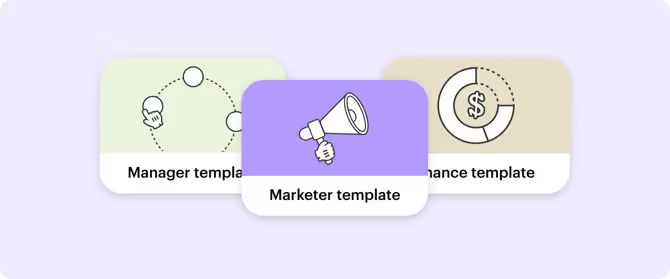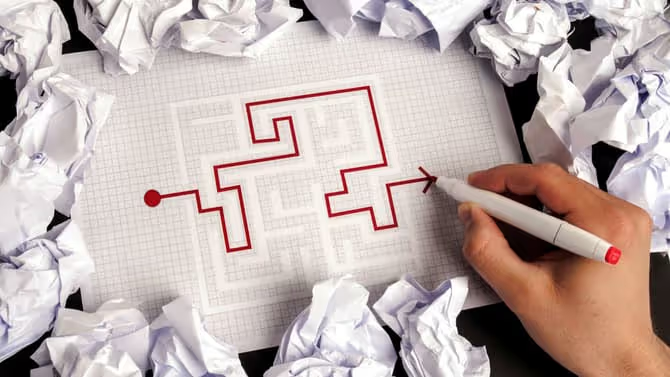Enabling manager productivity: Templates, tools, and resources for success

Discover Workleap Officevibe's benchmark report on 12 key employee engagement metrics

Managers have a huge impact on how employees feel about their jobs. When managers are on top of their game, their teams are engaged, productive, and just plain happier. But when they’re not? Well, you can guess how that goes.
As an HR pro, you know manager productivity is important. But here’s the thing: Enabling managers to be their best selves is just one of a million things on your to-do list. Whether you’re flying solo or leading an HR team, you simply don’t have the time to create detailed manager enablement programs from scratch or keep tabs on every little thing managers do.
But don’t worry — we’ve got your back. This article is packed with ready-to-use templates, tools, and resources that’ll help you boost manager productivity without burning yourself out.
Why HR is key to enabling manager productivity
Where fast-paced hybrid setups and digital overload are the norm, managers are facing more challenges than ever. With only 34% of U.S. employees feeling engaged at work, it’s clear that middle managers, who juggle countless responsibilities, need support. When managers struggle, the whole team feels it — engagement drops, productivity suffers, and turnover increases. That’s where HR steps in. By prioritizing manager productivity, HR can create a ripple effect, boosting engagement and driving team success across the board.
How productivity happens (and how HR can support it)
Understanding how productivity works is key to helping managers stay on top of their game. It’s not just about telling each other to work harder — it’s about understanding how our brains work.
It’s not about willpower
It turns out our brains don’t always help us stay on task. For instance, did you know that procrastination often happens because our brains like to tackle simple tasks first? This isn’t just laziness — it’s how we’re wired. HR can step in by creating systems that encourage managers to focus on what really matters, regardless of how they’re feeling in the moment.
The Zeigarnik effect
One key concept to understand is the Zeigarnik effect — the idea that unfinished tasks weigh heavily on our minds, causing stress and distraction. By helping managers prioritize and complete tasks effectively, HR can reduce this mental burden and keep managers focused and less overwhelmed. Additionally, HR can promote the importance of breaks and focused work periods, much like how athletes pace themselves during a marathon. These breaks are vital for maintaining productivity over the long haul.
Reconsider multitasking
Multitasking isn't for everyone. Sometimes, when people try to juggle too many things at once, their efficiency plummets. HR can support managers by encouraging single-tasking — focusing on one task at a time to get better results. This might involve providing tools that help managers set clear priorities and minimize distractions, ensuring they can give their full attention to each task.
By understanding these aspects of productivity, HR can craft training programs and systems that help managers stay productive regardless of their natural inclinations. It’s about setting them up for success with the right tools, knowledge, and support.
HR toolkit: Scalable solutions for manager productivity
The ideal scenario is that your productivity support tactics have longevity. That’s why scalable solutions are your best bet. The goal here is to provide managers with tools that are easy to use and consistently deliver great results, all while keeping your workload manageable.
Templates, resources, and tools to boost productivity
Effective management is all about having the right tools available. Streamlining processes with templates, resources, and software can make a significant difference in boosting productivity. These resources are designed to simplify complex tasks and improve efficiency to boost productivity.
Here’s how you can leverage these tools to enhance managerial effectiveness:
1. Welcome guide for new managers
Starting a new managerial role can be overwhelming. That’s why a solid welcome guide is a must. It sets the tone, introduces key processes, and gets new managers up to speed quickly. A good guide should cover everything from how to communicate with their team to the tools they’ll be using. Need a place to start? The Workleap New Manager Guide is a great resource.
2. Manager training courses
Learning never stops, especially for managers. It's crucial to keep them engaged and constantly improving their skills. With a learning management system, you can easily set up training courses that cater to your managers’ needs, from handling remote teams to improving time management.
3. One-on-one meeting templates
One-on-ones are where the magic happens. These meetings are key to addressing issues, clarifying roles, and setting expectations. But let’s be honest — planning and tracking meetings can be a hassle. That’s where templates come in handy.
Meetings for poor performance
Leverage this template to address performance issues effectively. Discuss specific concerns, set expectations, and agree on action steps. This approach ensures that the conversation is constructive and focused on improvement.
Regular one-on-ones meetings
These meetings are essential for ongoing feedback, support, and alignment. Using a consistent template helps maintain focus and ensures that both parties are prepared, leading to more productive conversations.
Meetings to address disengagement
You may start to see signs of disengagement through your pulse surveys or engagement tools. React fast by equipping your managers with this template for addressing disengagement.
Meetings to clarify roles and responsibilities
Use these meetings to clear up any confusion about roles. A good template will guide the discussion, helping both manager and employee define expectations and responsibilities clearly.
4. Team-building exercises
A team that trusts each other works better together. Simple as that. Whether it’s fun icebreakers for new hires or trust-building activities for established teams, these exercises are essential for keeping the team spirit high.
Sample meet-the-team questions
Start with icebreaker questions to help team members connect on a personal level. This can be as simple as “What’s your favorite hobby?” or “What’s one skill you want to learn?”
Want more? Grab a list of "get to know your staff" questions here.
Onboarding video templates
Managers can create engaging onboarding videos using an LMS to introduce new hires to the team. This ensures that new employees feel welcomed and informed from day one. Grab these templates to streamline video creation.
Trust-building templates
Implement trust-building exercises like team challenges or problem-solving activities. Your managers can also leverage these trust-building questions in their next one-on-ones.
5. Team and individual goal-setting guides
Setting goals is like giving your team a roadmap to success. Whether for the whole team or individual members, clear goals help everyone stay focused and aligned with the company’s objectives. With these templates, all your managers can be aligned on how they set goals with their teams and reports.
Team goal setting
Set team goals that align with the organization’s objectives using a collaborative approach. This template can help structure these sessions, ensuring that all voices are heard and that goals are clearly defined and actionable.
Individual career development plan
Assist employees in creating career development plans that align with their personal aspirations and the company’s needs. This guide (with a template attached!) will ensure that these plans are comprehensive and actionable, contributing to individual productivity.
{emphasize}
💡 Pro tip: Use Workleap Performance to help managers document goals
Workleap Performance allows managers and employees to set, track, and adjust goals over time. This tool helps ensure that goals are aligned, progress is monitored, and achievements are celebrated.
{emphasize}
Implementing the right templates, resources, and tools can transform managerial efficiency and productivity. These solutions not only support your managers but also contribute to a much more cohesive and motivated team.
Mastering prioritization: 5 tips to pass on to managers
To improve your manager’s prioritization skills, we’ve distilled key insights from research and expert advice. Apply these tips to boost productivity and help managers stay on top of their tasks.
1. Address team needs first
Encourage managers to be proactive about understanding and solving team issues before they escalate. Survey and feedback tools can help managers monitor team well-being well-being and know what to prioritize.
2. Use a tier system
Organization is an essential skill for every manager — and something you can help them develop. A great practice is to apply systems like priority tiers:
- Tier 1: High-priority tasks needing a manager’s direct involvement.
- Tier 2: Important but less urgent tasks that can be delegated or outsourced.
- Tier 3: Routine tasks that can be handled independently by their team.
This tier system helps managers quickly assess whether their attention is required or if tasks can be managed by others.
3. Apply a prioritization method
Suggest managers use the Eisenhower Decision Matrix to sort tasks by urgency and importance. This method helps identify what to delegate and what to decline based on two criteria: importance and urgency. It’s a good trick for streamlining a manager’s workload and making their own to-do lists feel less daunting.
4. Trust and delegate
Effective delegation hinges on trust. Managers need to empower their teams to handle tasks independently — that’s the only way to nurture self-sufficient employees. There’s a big difference between giving support and limiting an employee’s opportunities for growth. Encourage managers to embrace trust and delegation, even if it’s not always easy, as this will allow them to focus on higher-level responsibilities.
5. Adjust digital habits
This is a good tip for everyone (manager or not)! Productivity can be improved when digital distractions are well managed. Suggest to your managers to:
- Turn off unnecessary notifications.
- Check emails and messages at scheduled times.
- Reduce or eliminate meetings where possible.
By applying these changes, managers also communicate healthy habits to their team and ensure they maintain clarity and availability for urgent issues.
The HR edge: Enabling your managers to drive team excellence
When managers are productive, their teams and the entire organization benefit. And while enabling manager productivity might seem like just another task on your never-ending HR to-do list, it doesn’t have to be. By leveraging ready-made templates, tools, and resources, you can absolutely make a big impact by helping managers without a ton of extra work.
So, start working smarter, not harder! With the right tools in place, you’ll be able to support your managers effectively and ensure consistency across the board.
Ready to get started? Check out tools like Workleap Officevibe to help track one-on-ones, engagement data, goals, and more. With the right support, your managers — and their teams — will be unstoppable.
Give HR and managers the clarity, confidence, and connection to lead better every day.


%20(1).avif)


.avif)
.avif)








